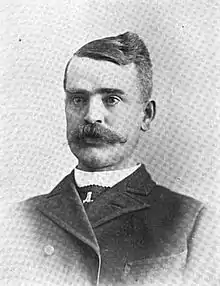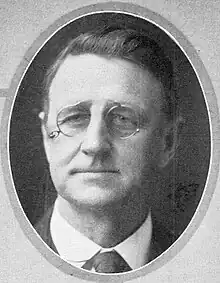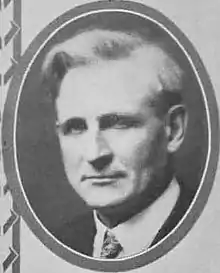| Lieutenant Governor of Nebraska | |
|---|---|
| Type | Lieutenant governor |
| Term length | Four years |
| Formation | 1877 |
| First holder | Othman A. Abbott |
| Website | https://ltgov.nebraska.gov |
The lieutenant governor of Nebraska is the highest-ranking executive official in the State of Nebraska after the governor. According to the Nebraska State Constitution, in the event a governor dies, becomes permanently incapacitated, resigns, or is removed from office, the lieutenant governor will become governor.[1]
Prior to the Constitution of 1875, Nebraska had no office of lieutenant governor. If the governor died, resigned, or was removed from office (as happened to Governor David Butler in 1871), then the Nebraska Secretary of State was appointed as Acting Governor until the vacancy would be filled by the next election.[2] The Constitution of 1875 created the office of Lieutenant Governor of Nebraska, leading to the first election of a lieutenant governor in Nebraska in the election of 1876.
Prior to 1962, both the governor and the lieutenant governor were elected to two-year terms, but in 1962, voters approved a constitutional amendment providing that the governor and lieutenant governor would be elected to four-year terms beginning in 1966. However, prior to 1974, the governor and the lieutenant governor ran independently and were elected on separate tickets in the general election, which is why sometimes Nebraska had a governor from one party but a lieutenant governor from another.[3] Starting in 1974, due to a constitutional amendment, the process was changed such that the governor and lieutenant governor candidates would secure their nominations independently in the primary elections in their respective parties, but then they ran together in the general election on one ticket from the same political party. Finally, by 2002, the constitution was again amended to allow gubernatorial candidates to choose their nominee for lieutenant governor after winning their respective parties’ primary elections, which means that the lieutenant governor is no longer elected independently of the governor at any stage.[3]
By law, the lieutenant governor presides over the Nebraska Legislature, acts as governor when the governor is out of the state or is incapacitated, and performs other duties assigned to him or her by the governor. Nebraska’s lieutenant governor also serves as the director of homeland security for the state and as the chairman of the Governor’s Homeland Security Policy Group. Before 1971, the office of lieutenant governor was considered a part-time position except during the biennial legislative session. When the Legislature began meeting annually, the office of lieutenant governor became a full-time position.[3]
Legislative role
As the highest-ranking presiding officer of the Nebraska Legislature, the lieutenant governor is known officially as the president of the Legislature.[4] When presiding, the lieutenant governor may vote to break a tie in the Legislature on any matter[5] except when the vote is on the final passage of a bill.[6] The lieutenant governor, in the role of presiding officer, also signs all bills and resolutions passed by the Legislature.[7] In the absence of the lieutenant governor, the speaker presides over legislative sessions.
List
- Parties
Republican (32 + 1 Acting) Democratic (9 + 1 Acting) Fusion (Democratic/Populist) (2)
Notes
- ↑ On May 1, 1901, after serving only four months as Governor of Nebraska, Charles H. Dietrich resigned from being governor as he had been elected by the Nebraska Legislature to fill the vacant U.S. Senate term of Monroe L. Hayward, who had died. Thus, Ezra P. Savage became the Governor of Nebraska and the office of Lieutenant Governor was vacant until after the election of Edmund G. McGilton in 1902.
- 1 2 Although Calvin F. Steele is not listed in recent editions of the Nebraska Blue Book as having served as Lieutenant Governor,[8] multiple sources from the time indicate that after the elevation of Ezra P. Savage to Governor, Steele was considered the acting lieutenant governor due to his position as president pro tempore of the Nebraska Senate based on a misinterpretation of Article V, Section 18, of the Nebraska Constitution. (Article V, Section 18, of the Nebraska constitution at the time provided that "If there be no lieutenant governor..., the president [pro tempore] of the senate shall act as governor until the vacancy is filled, or the disability removed...."[9] This would only take effect if the office of Governor of Nebraska was vacant and there was no Lieutenant Governor then in office to fill it. It should not have been applied to the case where only the office of lieutenant governor was vacant.) Thus, in the 1915 Nebraska Blue Book and the 1918 Nebraska Blue Book, Calvin F. Steele is listed as having served as Lieutenant Governor, even replacing any mention of Ezra P. Savage's brief stint as Lieutenant Governor.[10][11] Steele is also called the "former Lieutenant Governor" in a local newspaper account.[12] However, by 1920, Steele along with Morehead was not being included in the list of lieutenant governors of Nebraska in the Nebraska Blue Book[13] though some later editions of the Blue Book specifically noted in the list of lieutenant governors that Steele was the president pro tempore of the Nebraska Senate during the time that the lieutenant governor's office was vacant.[14]
- ↑ On May 2, 1911, Melville Hopewell died while in office, which left the office of Lieutenant Governor vacant until it was filled by the subsequent election of Samuel R. McKelvie.
- ↑ Although John H. Morehead is not listed in recent editions of the Nebraska Blue Book as having served as Lieutenant Governor,[8] multiple sources from the time indicate that after the death of Melville R. Hopewell, Morehead was considered the acting lieutenant governor due to his position as president pro tempore of the Nebraska Senate based on a misinterpretation of Article V, Section 18, of the Nebraska Constitution.[15][16] (See the note under Calvin F. Steele.[lower-alpha 2]) Thus, in the 1915 Nebraska Blue Book and the 1918 Nebraska Blue Book, John H. Morehead is listed as having served as Lieutenant Governor.[10][11] It is also said in a local newspaper account from the time that Morehead "became acting Lieutenant Governor of the state"[17] and other newspaper accounts from the time referred to him as the "lieutenant governor" or "acting lieutenant governor."[18][19] However, as soon as 1920, he was not being included in the list of lieutenant governors of Nebraska in the Nebraska Blue Book[13] though some later editions of the Blue Book specifically noted in the list of lieutenant governors that Morehead was the President pro tempore of the Nebraska Senate during the time that the lieutenant governor's office was vacant.[14]
- ↑ Walter H. Jurgensen was removed from office in June 1938 after being convicted in March 1938 of embezzling $549 in a stock transaction between a co-defendant and a railroad station agent in September 1934. Jurgensen contested the conviction and sought renomination for a fourth term as lieutenant governor, but he was declared ineligible to participate in the primary.
- ↑ Nate M. Parsons was elected in a special election to fill out the remainder of the term of Walter H. Jurgensen, who was removed from office. He served in office from Nov. 8, 1938, to Jan. 5, 1939.
- ↑ On Sept. 24, 1955, Charles J. Warner died while in office, which left the office of Lieutenant Governor vacant until it was filled by the subsequent election of Dwight W. Burney.
- ↑ On Sept. 9, 1960, Governor Ralph G. Brooks died in office, which caused Dwight W. Burney to become the Governor of Nebraska. He served out the remaining four months of Brooks' term and was subsequently reelected to the office of Lieutenant Governor in 1960.
- ↑ Maxine B. Moul resigned in 1993 to become the director of the Nebraska Department of Economic Development.
- ↑ Kim M. Robak was appointed by Governor Ben Nelson on Oct. 6, 1993, to complete the term of Maxine B. Moul, who had resigned. She was subsequently elected to the office in 1994.
- ↑ David Maurstad resigned in 2001 to become the director of the Federal Emergency Management Agency, Region VIII.
- ↑ Dave Heineman was appointed by Governor Mike Johanns on Oct. 1, 2001, to complete the term of David Maurstad, who had resigned. He was subsequently elected to the office in 2002.
- ↑ Dave Heineman became the governor on January 20, 2005, following Governor Mike Johanns's resignation to become United States Secretary of Agriculture in President George W. Bush's administration.
- ↑ Rick Sheehy was appointed by Governor Dave Heineman on Jan. 24, 2005, to finish his own term since he had become Governor. Rick Sheehy was subsequently elected to the office in 2006.
- ↑ Rick Sheehy resigned on Feb. 2, 2013, with a two-sentence resignation letter, after it was reported that he had been using his state-issued cell phone for years to make 2,000 late-night telephone calls to four different women who were not his wife.
- ↑ Lavon Heidemann was appointed by Governor Dave Heineman on Feb. 13, 2013, to finish the term of Rick Sheehy, who had resigned.
- ↑ Lavon Heidemann resigned on Sept. 9, 2014, after his sister obtained a restraining order against him, alleging that he had physically assaulted her in the course of a dispute over the care of their elderly mother. Heidemann had been chosen by then-candidate for Governor Pete Ricketts as his running mate for Lieutenant Governor, but he withdrew from the Ricketts ticket in light of his resignation.
- ↑ John E. Nelson was appointed by Governor Dave Heineman on Sept. 29, 2014, to finish the term of Lavon Heidemann, who had resigned.
See also
References
- ↑ "Nebraska State Constitution Article IV-16". Nebraska Legislature.
- ↑ "Nebraska Constitution of 1866, Article III, Section 16".
- 1 2 3 Nebraska Blue Book (PDF), p. 413
- ↑ "Glossary of Legislative Terms". Nebraska Legislature. Retrieved November 20, 2022.
President of the Legislature - the lieutenant governor. While senators address whoever is in the chair as Mr. or Madame President, the lieutenant governor alone holds that official title.
- ↑ "Nebraska State Constitution Article III-10". Nebraska Legislature.
- ↑ "Nebraska State Constitution Article III-13". Nebraska Legislature.
- ↑ "Nebraska State Constitution Article III-14". Nebraska Legislature.
- 1 2 "2020-21 Nebraska Blue Book" (PDF), Nebraska Legislature, p. 415
- ↑ 1915 Nebraska Blue Book (PDF), p. 168
- 1 2 1915 Nebraska Blue Book (PDF), p. 11
- 1 2 1918 Nebraska Blue Book (PDF), p. 11
- ↑ "Federal Court Petit Jury: Ex-Lieutenant Governor Steele and Several Prominent Men on the Panel", Omaha Daily Bee, May 31, 1906
- 1 2 1920 Nebraska Blue Book (PDF), p. 22
- 1 2 1956 Nebraska Blue Book (PDF), p. 115
- ↑ "Gov. John Henry Morehead", National Governors Association
- ↑ Nancy Capace (January 1, 1999). Encyclopedia of Nebraska. Somerset Publishers, Inc. p. 106. ISBN 9780403098347.
- ↑ "John H. Morehead: Democratic Candidate for Nomination for Governor of Nebraska", Red Cloud Chief, April 4, 1912
- ↑ "Hon. John H. Morehead", Plattsmouth Journal, March 28, 1912
- ↑ "Political Advertisement: John H. Morehead", The Daily Nebraskan, April 19, 1912

.jpg.webp)
.jpg.webp)



.jpg.webp)
.jpg.webp)





.jpg.webp)


.jpg.webp)


.jpg.webp)






.jpg.webp)







.jpg.webp)

.jpg.webp)


